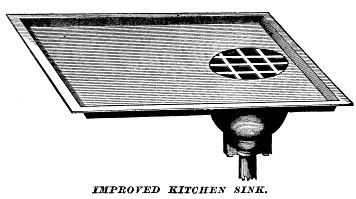THE sink is without doubt one of the most essential features in a modern kitchen, but at the same time it has, unfortunately, thus far been a neglected piece of manufacture, being made after a certain accepted form, without any attempt at improvement to overcome the inherent defects of that form. Let us see what these defects are.
First, the grate over the waste pipe gets very easily choked up, when at once the whole sink is changed into a puddle of dirty water, and anything placed in it to drain is inundated. Second, the high sides necessary to overcome the inconvenience by overflow from this cause, are very tempting to the servants to place the dishes against on edge, when they often slide down and are damaged, or any crockery standing around the edge and sliding into the sink is sure to break by the depth of the fall. These two great defects have been overcome by the construction of a new form of sink, called the Cottage Sink, and made by Messrs. Child & Backus, of Rochester, N. Y. Instead of attaching the waste pipe directly to the flat bottom of the sink, they make this connection by the intervention of a large semi-globular receptacle or slop-bowl, which, with its open upper portion is attached below a large circular opening in the bottom of the sink, while the waste pipe is connected to the bottom of this bowl by means of a stench-trap. There are two grates, a loose one, with large openings, on top of the bowl, and flush with the flat bottom of the sink, and a second one fixed with fine openings at the top of the waste pipe, where it connects with the bottom of the bowl. The next improvement, made possible by the attachment of the slop-bowl, is to make the sink quite shallow, so that the dangerous high edges are absent and replaced by low ones. The whole arrangement is represented in our engraving of this sink, and all who have noticed the defects of the ordinary sinks will at once appreciate its advantages. When the close grate on top of the waste-pipe gets choked up, no water will accumulate in the sink, but it will commence to fill the bowl, and when it is so full as to commence overflowing, the flat bottom of the sink, it is easily emptied by removing the grate covering it and clearing away the obstruction at its bottom, when it will at once empty itself and be ready for receiving the drainage of anything placed on the grate in top, or anywhere on the bottom or around the sides of the sink.
A modified form of slop-bowl, 7 inches deep and 10 inches diameter in top, is also made, to be attached to wooden sinks, lined with zinc, copper, or galvanized iron; it costs $3, while the lower coupling is adjusted for either lead or iron waste pipe.
The plumber’s kitchen sink here described can be obtained in every variety of form wherefore sinks are used. The sizes vary from 18 x 28 to 22 x 44 inches, and the corresponding prices from $3.25 to $6.75. It is evident that this style of sink far surpasses in cleanliness and economy any other style in use, while even its cost is below that of the old style inferior sinks, which perhaps will be the most powerful agency to its universal introduction.

